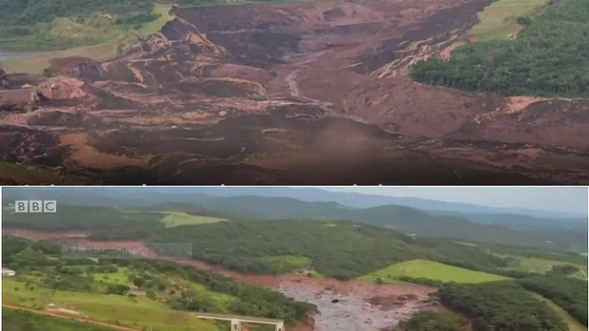It is worth noting that in contrast to water-retention dams, which are dismantled if they cannot be inspected and maintained, tailings dams are simply abandoned after mine closure under the assumption that they will hold back toxic mine tailings in perpetuity with no further maintenance and inspection, therefore, the utmost safety in construction is essential.
The Mirador Mine in Ecuador is being built with two huge waste dumps, (tailings storage facilities). The mine, when in full operation, is expected to produce 60,000 tons of mining waste tailings every day!
The foundations of the Mirador Mine are alluvial sediments.
In response to questions from the Ecuador Ministry of Environment in 2011, EcuaCorriente, quoted from the 2007 report by Knight-Piesol.
This report was originally written in English and was later translated into Spanish by Walsh Walsh Scientists and Engineers. This part in the original English refers to liquefaction caused by earthquakes.
Knight-Pièsold, 2007. Rio Quimi Tailings Management Facility Feasibility Study for 27,000 tpd mine production [Estudio de viabilidad de la Instalación de Gestión de Relaves Río Quimi para 27,000 tpd de producción minera]. Ref. No. VA201-78/09-2, 111 p.
The dam could collapse by seismic liquefaction of the tailings without failure (or liquefaction) of the foundations. The report says that both factors are a potential for collapse; The combined, or separate potential realized would release hundreds of millions of tons of toxic waste into the sensitive and vital river systems of the Upper Amazon Basin.
The vision of the dam walls sliding into their foundations with millions of tons of toxic waste pouring over the collapsed walls is a nightmare that we do not want to experience.
The present plan increases tailings from 27,000 tons a day to 60,000 tons a day.
The torrent of toxic waste, millions of metric tons, would flow through the steeply inclined river system to reach a main tributary of the upper Amazon rainforest, the Santiago River, and from there it will continue its passage to the Amazon River. This will be a veritable nightmare of pollution.
In the case of a high rainfall event leading to collapse, the fastest-moving mine tailings would reach the next major confluence where the River Zamora meets the River Santiago, (about 88 km downstream from the Rio Quimi – Rio Zamora confluence), within 5 hours!
The Tundayme dam. The Chinese are building what is projected to be the tallest tailings dam in the world. This dam, in the valley of the Tundayme River will be 260 meters high, and built with an inclination of 1 meter vertical to 1.5 meters horizontal. (Cardno EIS 2014)
Cardno, 2014. Actualización del Estudio de Impacto y Plan de Manejo Ambiental, para la Fase de Beneficio de Minerales Metálicos (cobre), Ampliación de 30 kt por día a 60 kt por día del Proyecto Minero Mirador, Concesión Minera “Mirador 1 (acumulada)”: Informe a EcuaCorriente S.A., 1206 p. con 6 anexos (1125 p.).
The Tundayme dam was not yet under construction when Dr Emerman visited the site on November 6th, 2018.
The dangers of building the tallest tailings dam in the world at a steep angle of slope are clear as stated in a quote I am taking from Dr Emerman:
The Environmental Impact Study of 2010 had advised a slope of 1 meter vertical to 2 meters horizontal.
The consequences of the Tundayme collapse will be much greater than that experienced in other tailings dam failures simply because the dam is higher, the highest in the world, meaning that the released tailings will travel a greater distance at a greater speed.
The facility at Quimi, There are two facilities at the Mirador mine. This facility will incorporate walls at a height of 63 meters
The 2014 Cardno EIS said that the Quimi dam should be built at a slope of 1 meter vertical to 2 meters horizontal.
Dr Emerman in his visit to the facility on November 6th 2018 noted that the slope being built was 1 meter vertical to 1 meter horizontal, a slope angle referred to as a critical angle building on the edge of collapse.
The dam is being built at a critical slope angle. This is building on the edge of collapse.
Civil engineering structures are not supposed to be built at a critical state at the edge of failure!
Water-retention dams have stricter safety standards. The U.S. Army Corps of Engineers recommends an embankment angle of no steeper than 1 meter vertical to five meters horizontal for the prevention of piping.
The Quimi facility dam is supposed to hold back an excessively wet mass of tailings in perpetuity. The dam is being built in a manner where piping and collapse are inevitable.
The Mirador Mine facilities are being built in the tropical cloud forests of the Cordillera del Condor with a rainfall of 1.85 metric tons per square meter per year.
The risk category “Very High” was confirmed by ECSA in their 2011 responses to questions from the Ministry of the Environment.
This information was dropped from the Cardno 2014 EIS. Cardno consultants worked on a decision to build for a 500 year flood even though the risk had been increased owing to a doubling of tailings.
Flood standards are not being met in the design of the Mirador Mine tailings facilities.
The tailings storage facilities at the Mirador Mine are being built in violation of the Cardno 2014 EIS. The EIS states that the Quimi facility, now under construction, was to be built with a centerline construction with a 1 meter vertical to 2 meters horizontal slope. As I explained earlier, the Quimi facility is being built at a critical slope. on the edge of collapse.
Collapse due to earthquake, flooding, internal erosion, static liquefaction, and foundation failure are all likely.
In the next part of this article I am drawing your attention to examples of various dam collapses around the world and their resulting devastating environmental consequences.




